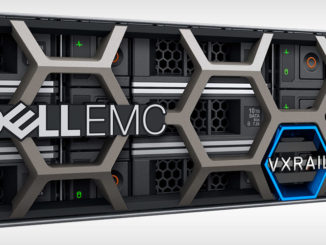
What happens when the world’s largest public cloud and the biggest peddler of server virtualization in the enterprise team up to create a hybrid cloud?
A few things. First, the many VMware partners who have built clouds based on the ESXi hypervisor get nervous. And second, VMware very delicately and carefully prices its software low enough that it can have a scalable public cloud play but not so low that Amazon Web Services doesn’t end up having the pricing leverage that its parent company had with the book business a decade ago. And third, AWS uses the might of a potential competitor to expand its datacenter footprint and its scale, making it all that much more unassailable by others.
It is a real question of who is working for whom. The partnership that AWS and VMware inked last week, for which financial details were not disclosed, is a landmark one for sure. But the effects of this deal between the two juggernauts of their respective industries are far from certain. A lot depends on the details of the transaction (which we will never know) and how aggressively both companies push this new VMware Cloud on AWS service. This deal does not, in any way, solve the private cloud problem that AWS has, but it sure does give VMware a much better public cloud story to tell.
The arrangement between VMware and AWS calls for AWS to bestow the mantle of preferred private cloud partner to VMware and for VMware to anoint AWS as its preferred public cloud partner. It is debatable how value either of these are.
What is significant in the deal is that VMware is essentially paying AWS to stand up public cloud instances within its cloud datacenters based on the ESXi-vSphere-NSX-VSAN stack, something VMware cannot afford to do on its own. Think about it for a second. VMware has over 500,000 enterprise customers using its ESXi hypervisor and related vSphere server virtualization tools to manage somewhere between 50 million and 60 million virtual machines across millions of systems, and this platform will generate around $7 billion this year and bring maybe $1.2 billion of that to the bottom line.
By contrast, as we detailed in our recent analysis of AWS, the public cloud provider had $7.88 billion in sales in its trailing twelve months ended in June and brought $1.5 billion in as operating income. And more stunningly, if current trends persist, AWS might break $12 billion in sales and $3 billion in operating profit for 2016. Which means AWS, which has over 1 million customers and now lots of access to a half million more, has just passed VMware as the virtualization juggernaut of the world, to one way of thinking about it.
Show Me The Money
For a thought experiment, let’s say that all enterprise customers want public cloud versions of their VMware stacks for existing workloads (not new stuff that will end up on Photon Platform or AWS proper or another cloudy substrate), and let’s say that maybe a third of their capacity – call it 20 million VMs for fun – might end up on a public cloud running the VMware stack. VMware might drive $2.3 billion in incremental software revenue per year from those public cloud VMs, and it might even put another $400 million on the bottom line. But just how expensive would it be to build the datacenters to support those 20 million VMs? Just putting an average of 40 VMs on a server, which is not a bad ratio these days, would require 500,000 servers that might cost somewhere around $2.5 billion at a mere $5,000 a pop. Sure, VMware should have $9.4 billion in the bank by year end, if Michael Dell doesn’t grab it to pay down the debts from acquiring EMC for $60 billion in September (and therefore getting his hands on VMware), so it could afford to buy all those servers, but wrapping storage and networking around those servers would probably add billions more, and datacenter skins and power contracts are also not cheap. Call it a $5 billion investment or so for the complete datacenters housing those 500,000 machines. And, oddly enough, if those 500,000 enterprise customers are more aggressive and want to add 40 million VMs to the cloud, then there goes all of the money VMware has in the world, all for an incremental $800 million a year in net income.
This is why it is so hard to break into the public cloud, even if you can sell yourself the entire software stack for essentially nothing, as VMware can. This is why VMware, which tried to build its own vCloud Air public cloud, and rapidly backed off on that idea. Hewlett Packard Enterprise and Dell tried to do the same a few years ago and stopped because of the untold billions it would take to compete with IBM SoftLayer and Rackspace Hosting, much less AWS, Microsoft Azure, and Google Cloud Platform. To be sure, the vCloud Air Network of partners still exists, but you have to wonder how happy Verizon or SoftLayer are knowing that AWS is building true VMware clouds based on the whole stack, and they surely want to know what the pricing will be on the VMware Cloud on AWS because they have to buy the VMware stack and VMware doesn’t, and because AWS probably has the cheapest per server cost in the world and they don’t.
By one way of looking at this partnership, AWS seems to finally have a private cloud story to tell (but not really the one it needs to tell for customers that use its AWS cloud and the metaphor of compute, storage, networking, and management it embodies. There is still no private cloud version of AWS, which was the point. VMware finally has a big public cloud story to tell, and we are pretty sure that AWS is making plenty of coin on the deal, don’t worry. But we still say that what customers really want is a version of the AWS public cloud that they can run privately in their datacenters and link out to the real AWS cloud for hybrid operation. What this deal really does is help AWS grow its datacenters with a new workload and potentially set itself up to pull workloads out of enterprise datacenters and onto its clouds over the long run. Yes, will be only a couple of clicks to VMotion live migrate a VM from a datacenter to the AWS iron running the VMware stack, but it might only take a couple of more clicks to convert a VM based on the ESXi hypervisor to an AMI image running on the custom Xen hypervisor that AWS uses underneath its EC2 compute cloud.
But of course neither Andy Jassy, CEO at AWS, nor Pat Gelsinger, CEO at VMware, are going to say that. Maybe part of the deal is that AWS will not try to poach VMware customers running inside its own AWS datacenters.
The most important thing for VMware is that the VMware Cloud on AWS will be a showcase for the technologies that VMware has created and assembled over the past four years to create a cloud stack of its own. Companies that want to see what happens when they mix NSX virtual networking and VSAN virtual storage with ESXi hypervisors and vSphere management tools will be able to do it on a cloud, with on-demand or subscription pricing, rather than by buying lots of iron and software upfront and breaking the capital expenses budget. So far, there are around 1,700 customers using NSX virtual networking and more than 5,000 customers using VSAN virtual storage, so you can’t exactly call these bit barn burners – at least not against the size of the VMware installed base. While NSX and VSAN are ramping – and apparently doing far better than the vCloud cloud management tools have done – they have not even begun to dent the VMware installed base.
The good news for VMware’s existing enterprise customers is that when they log into the VMware Cloud on AWS, they will see the same vCenter console they know and love and they will not have to speak in AWS instance types or in S3 object or EBS block storage formats. Mike Adams, senior director of cloud platform product marketing at VMware, tells The Next Platform that the AWS version of the VMware stack will have the same hierarchy of management – datacenters down to vSphere hosts down to individual ESXi VMs. This is so much better for these existing shops than what could have happened, which would be to have AWS change out its homegrown Xen hypervisor and swap in ESXi and try to make the actual AWS cloud work. This would have abandoned NSX and VSAN, which would have been bad for VMware, and probably resulted in an inferior experience on the AWS cloud. With VMware selling and operating the VMware Cloud on AWS, if there is a bad experience, it will all come back to VMware, not AWS, which is essentially a co-lo datacenter facility for VMware.
Adams says that the VMware Cloud on AWS will go into beta testing in the first quarter of 2017, and that it will be generally available in the middle of next year. Pricing details were not announced, but Adams told us that VMware would sell on-demand, metered capacity as well as subscriptions, which is what VMware is calling reserved instances. VMware has not divulged what metering it will use, but presumably hourly for compute and storage capacity and fees for moving data across the network. VMware’s subscriptions will come with one-year and three-year terms, and will offer discounted pricing for workloads that have a set amount of compute and storage and that are not likely to move around or change much – precisely like a lot of enterprise workloads do today that run atop ESXi. VMware is not talking about what AWS iron it is running on, and it will no doubt be precluded from divulging details about Amazon’s homemade servers, storage, and networking.
Embrace, Extend. . .
The integration between the VMware stack and the actual AWS cloud will be a little thin at first, but over time it could grow, and it is in the vested interest of AWS to get VMware shops in the public cloud used to using AWS services as adjuncts to the virtual compute, storage, and networking delivered on the VMware Cloud on AWS service.
“We do have the VPC pairing mode, so you can see into other AWS services,” says Adams. This includes EC2 compute or S3, EBS, and Glacier storage, or the range of database services like Aurora, DynamoDB, Redshift, and Elastic MapReduce. And the VMware stack running on AWS will be able to use a variety of migration services, such as Direct Connect networking, Snowball data movement, S3 Transfer Acceleration, or Storage Gateway to move data and applications out of the VMware environment into the AWS environment proper. As for tighter integration between the VMware stack and AWS services – specifically supporting AWS APIs within the VMware stack, which would possibly be of great value to enterprises – all that Adams would say was that “we will investigate how we will expand integration moving forward,” adding that this was still in technology preview status. “All of those things are possibly on the table after we see what customers are demanding.”
Interestingly, Adams said that one thing that customers could do is run vSphere integrated Containers, the variant of the vSphere stack revved up to run Docker containers, on top of the VMware Cloud on AWS stack. Ditto for VMware Integrated OpenStack (VIO), which is a bundle of OpenStack with ESXi as its hypervisor substrate.
“Photon Platform will be more of a development effort because it is a platform in and of itself, it is not just a feature being added to vSphere itself,” Adams explains. “That would be different. But we think we could evolve into that world as we go along, although we have not announced any specific plans to do that. It is possible as we look forward.”
How popular the VMware Cloud on AWS becomes, and how much revenue it will drive, will come down to pricing. And that comes down to what AWS is charging for its datacenter capacity. Before this is all done, maybe Verizon, CenturyLink, NTT, and other vCloud Air Network partners will throw in the towel and just resell the VMware service running on AWS iron and be done with it. Apparently there will be plenty of margin to go around.
The question now is this: Is Gelsinger talking to Diane Greene, the co-founder of VMware that now runs Google Cloud Platform? AWS was the logical partner for VMware, but there is no reason VMware can’t do similar deals with Google or Microsoft. If Microsoft will sell Linux slices, it can sell ESXi slices. Similarly, if AWS will host VMware’s stack, there is no compelling reason why it cannot host Microsoft’s Azure Stack or Red Hat’s CloudForms. We don’t expect this, mind you. But the logic of openness holds. Once you open the datacenter for one, you can open it for all.
It might have been simpler and cleaner had AWS just launched private cloud variants of its own infrastructure, as rival Microsoft is set to do with Azure Stack running atop Windows Server 2016.





There is only one word to describe this if you follow VMware : capitulation. VMware had multiple chances to build a good private cloud. They failed starting with vCloud director and then vCloud air. Now they are baby sitting their customers’ journey to AWS. Hopefully one day there will be a Harvard Business School case study on how this could have been avoided.